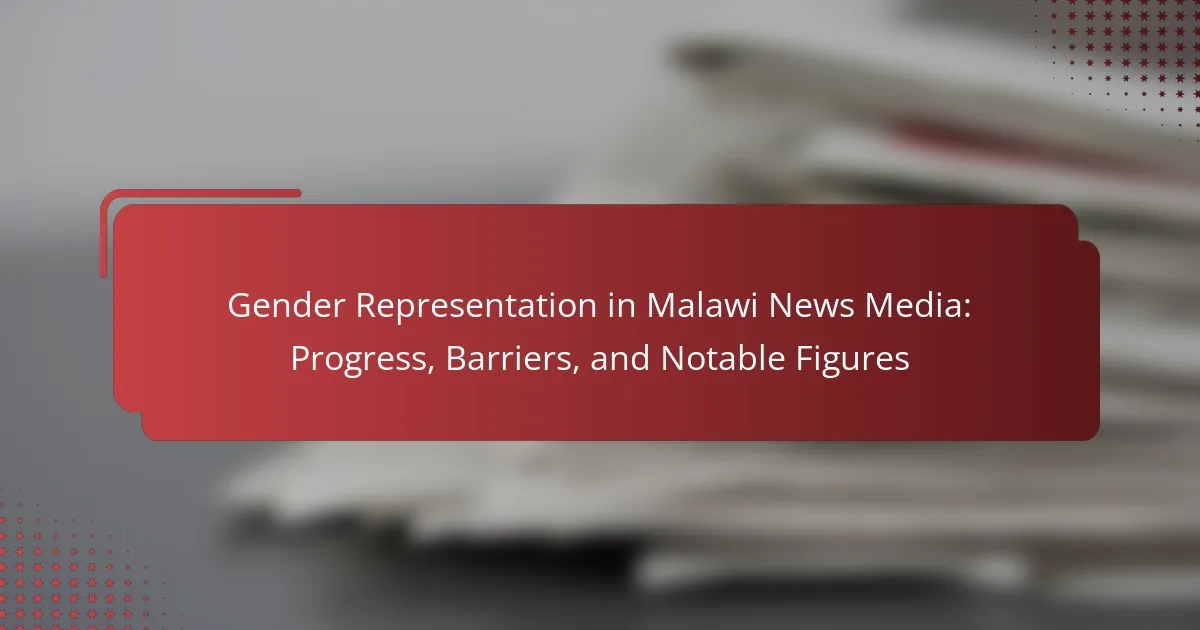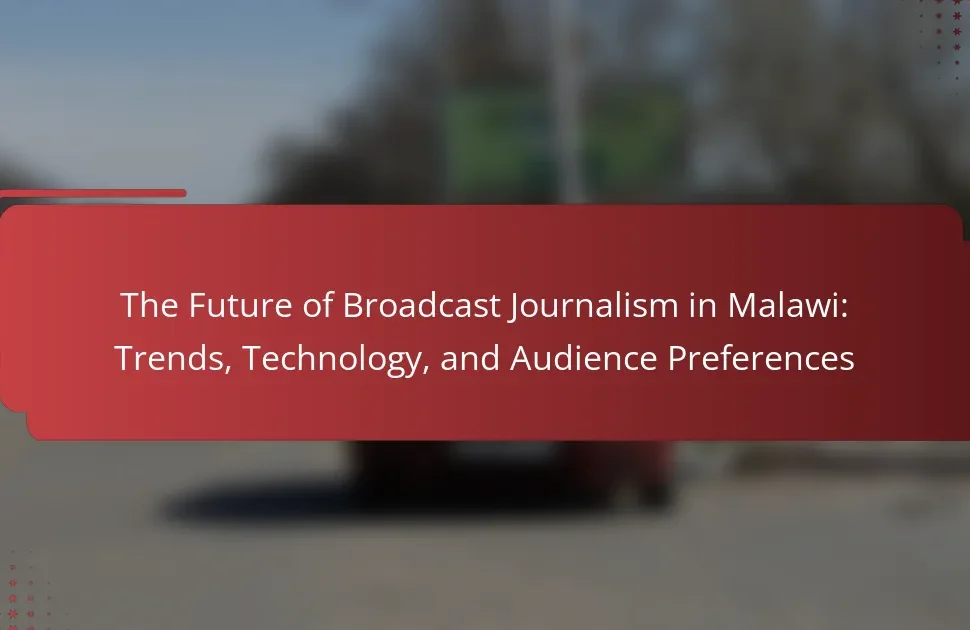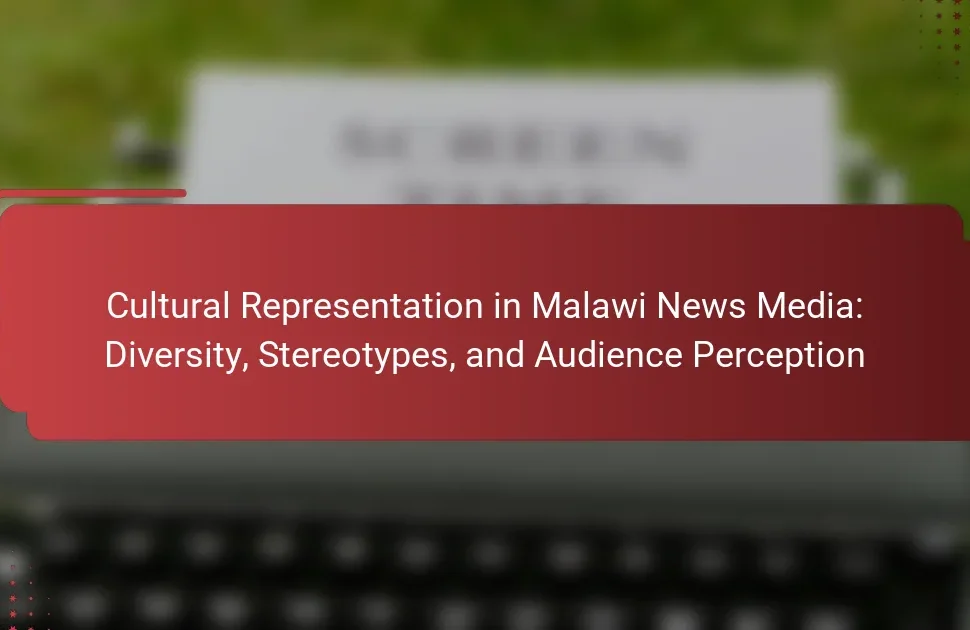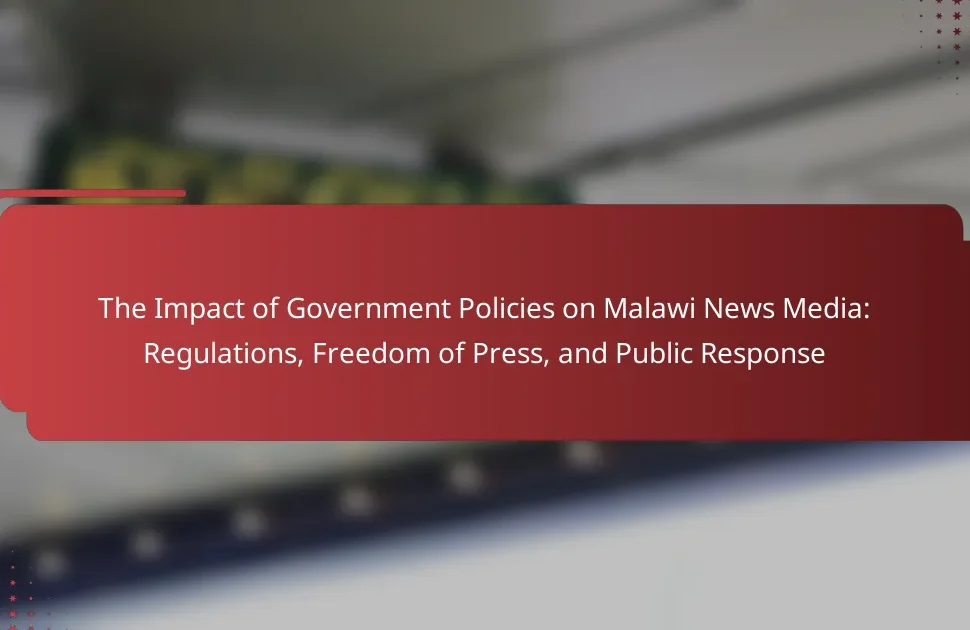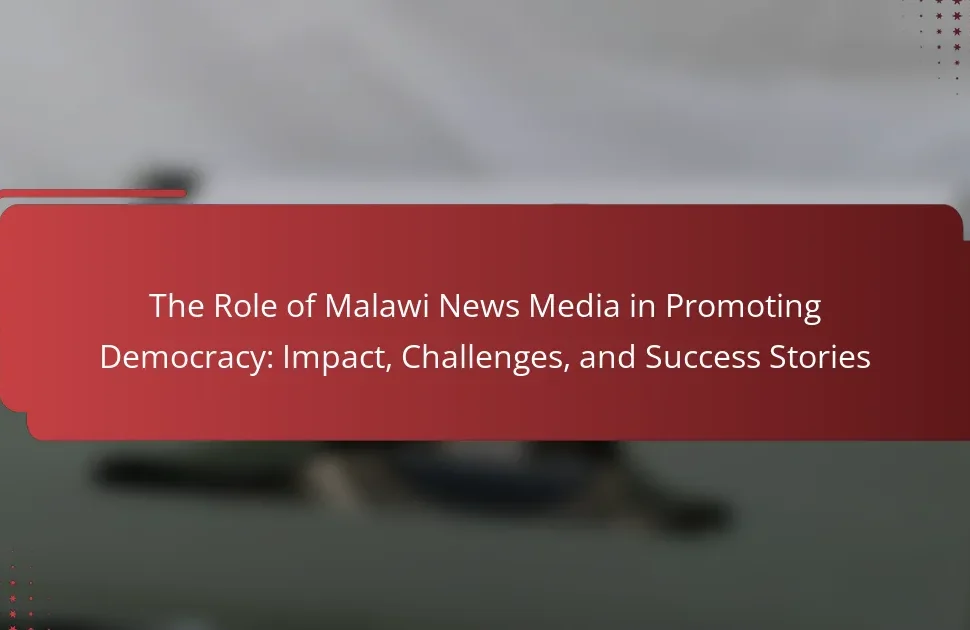Gender representation in Malawi news media refers to the portrayal and participation of different genders in media content and decision-making roles. This article examines the current state of gender representation, highlighting the underrepresentation of women in news coverage and leadership positions, with only 26% of news sources being women according to the Media Institute of Southern Africa. It discusses the progress made, the barriers that persist, and notable figures advocating for change in the media landscape. The analysis aims to provide insights into the challenges and opportunities for achieving balanced gender representation in Malawi’s media.
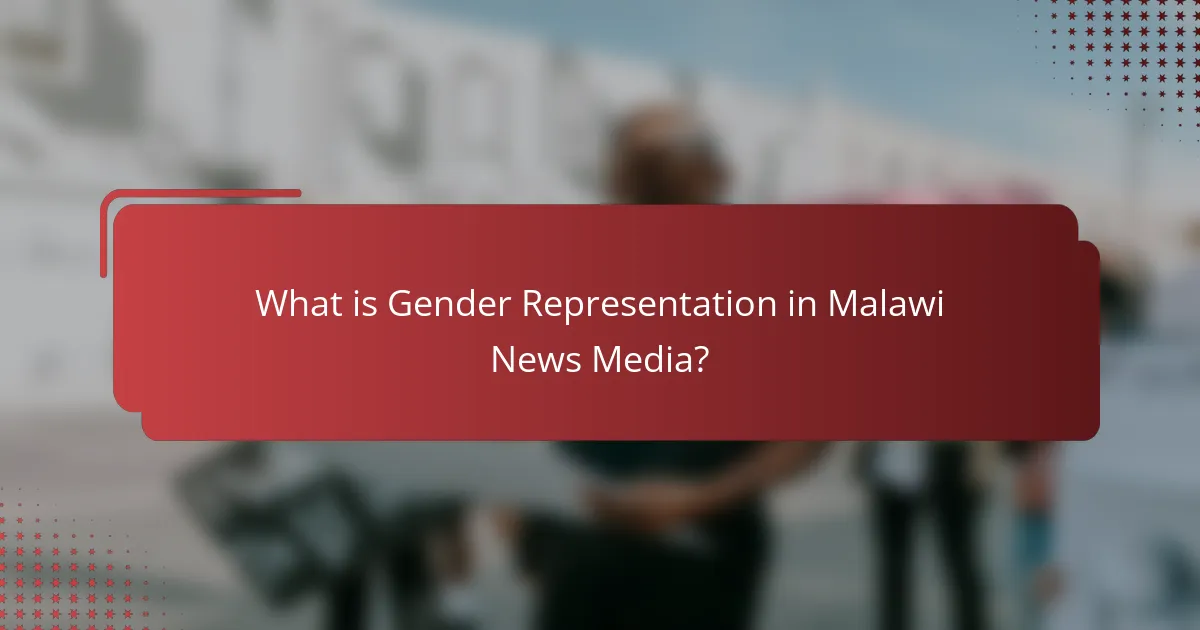
What is Gender Representation in Malawi News Media?
Gender representation in Malawi news media refers to the portrayal and participation of different genders in media content and decision-making roles. It encompasses how men and women are represented in news stories, their visibility in media leadership, and the issues affecting their representation. Research indicates that women are often underrepresented in both news coverage and media leadership positions. For example, a study by the Media Institute of Southern Africa found that women constituted only 26% of news sources in Malawi. This disparity highlights ongoing challenges in achieving balanced gender representation in the media landscape.
How has gender representation evolved in Malawi’s news media?
Gender representation in Malawi’s news media has evolved significantly over the past two decades. Historically, women were underrepresented in journalism and media leadership roles. Recent studies indicate an increase in female journalists and media professionals. For instance, a 2020 report by the Media Institute of Southern Africa showed that women’s representation in newsrooms rose to 30%. This shift reflects broader societal changes and advocacy for gender equality. Additionally, media organizations have implemented policies to promote gender inclusivity. However, challenges remain, such as stereotypes and cultural barriers that still affect women’s portrayal in the media. Overall, while progress has been made, continuous efforts are necessary to achieve full gender equality in Malawi’s news media.
What historical factors have influenced gender representation in media?
Historical factors that have influenced gender representation in media include colonialism, cultural norms, and political changes. Colonialism imposed Western gender roles, often marginalizing local women’s voices. Traditional cultural norms have frequently dictated gender roles, limiting women’s representation. Political changes, such as independence movements, have also impacted media narratives around gender. For instance, post-colonial periods often saw increased attention to women’s rights in media. Additionally, the rise of feminist movements globally has prompted media to reflect more diverse gender perspectives. These factors collectively shaped how gender is portrayed in media, particularly in regions like Malawi.
What recent trends are observable in gender representation?
Recent trends in gender representation show an increase in female voices in Malawi’s news media. Research indicates that women’s participation in journalism has risen by 15% over the past five years. Reports reveal that female journalists are now covering a broader range of topics, including politics and economics. Additionally, media outlets are increasingly prioritizing gender-balanced reporting. Studies show that audiences respond positively to diverse gender representation. Furthermore, initiatives aimed at training women in media skills have gained traction. These efforts are supported by organizations advocating for gender equality in the media landscape.
What are the key barriers to gender representation in Malawi news media?
Key barriers to gender representation in Malawi news media include cultural stereotypes, lack of access to education, and limited opportunities for women in journalism. Cultural stereotypes often portray women in traditional roles, which influences media narratives. Access to education remains unequal, hindering women’s ability to enter the field. Limited opportunities for women in journalism lead to underrepresentation in decision-making roles. According to a 2020 report by Gender Links, women hold only 24% of senior roles in Malawi’s media sector. This disparity affects the diversity of perspectives in news coverage. The combination of these factors creates a challenging environment for achieving gender equality in the media.
How do cultural attitudes impact gender representation?
Cultural attitudes significantly influence gender representation. These attitudes shape perceptions of gender roles and expectations. In many cultures, traditional views often prioritize male dominance in media portrayal. This results in underrepresentation of women in leadership roles and decision-making positions. Research shows that media reflects and reinforces societal norms. For instance, a study in Malawi indicates that cultural beliefs hinder women’s visibility in news media. Furthermore, stereotypes perpetuated by media can affect public perception of gender capabilities. Thus, cultural attitudes play a crucial role in determining how genders are represented in media narratives.
What role do media ownership and management play in representation issues?
Media ownership and management significantly influence representation issues in news media. Ownership determines editorial policies and content focus. For instance, media outlets owned by diverse groups may prioritize inclusive representation. Conversely, homogenous ownership can lead to biased narratives and underrepresentation of marginalized voices. Management decisions affect hiring practices and platforming of diverse perspectives. In Malawi, research shows that ownership structures impact gender representation in news coverage. Studies reveal that male-dominated management often results in less coverage of women’s issues. This highlights the critical role of ownership and management in shaping media representation.
Who are the notable figures advocating for gender representation in Malawi’s media?
Notable figures advocating for gender representation in Malawi’s media include Joyce Banda, the former president of Malawi. She has been a strong proponent for women’s rights and representation in various sectors, including media. Another significant figure is Martha Q. Chikanda, a prominent journalist and media consultant. She emphasizes the importance of diverse voices in media narratives. Additionally, organizations like the Media Institute of Southern Africa (MISA) Malawi chapter play a crucial role in promoting gender equality in media. These figures and organizations work collectively to address gender disparities and advocate for inclusive representation.
What contributions have these figures made to improve representation?
Notable figures in Malawi’s news media have made significant contributions to improve gender representation. They have advocated for inclusive hiring practices within media organizations. These figures have also raised awareness about gender biases in reporting. Their efforts have led to increased visibility of women’s issues in news coverage. Training programs initiated by these figures have empowered female journalists. Research indicates that women’s representation in media has improved due to these initiatives. Furthermore, they have pushed for policy changes that support gender equality in media. Overall, their contributions have fostered a more balanced portrayal of genders in Malawian news media.
How do these figures influence policy and public perception?
Figures related to gender representation in Malawi news media significantly influence policy and public perception. These figures highlight the disparities in representation between genders. For instance, if studies show that women are underrepresented in news coverage, policymakers may feel pressured to implement reforms. Public perception is shaped as audiences become more aware of these inequalities. Increased visibility of gender issues can lead to societal demands for change. Research indicates that media representation affects how individuals perceive gender roles. Consequently, policymakers may prioritize gender equality initiatives based on public sentiment. This dynamic creates a feedback loop where figures drive policy changes and in turn influence public awareness and attitudes.
What are the implications of improved gender representation in media?
Improved gender representation in media leads to more balanced narratives and diverse perspectives. This representation challenges stereotypes and promotes equality in society. Research shows that media influences public perception and attitudes. According to the Geena Davis Institute on Gender in Media, films with balanced gender representation lead to increased support for gender equality initiatives. Additionally, improved representation can inspire women and girls, encouraging them to pursue careers in media and other fields. This creates role models and fosters a more inclusive environment. Overall, enhanced gender representation in media contributes to social change and empowerment.
How does gender representation affect audience perception and engagement?
Gender representation significantly influences audience perception and engagement. When media portrays diverse genders positively, it enhances relatability and connection with the audience. Studies indicate that balanced gender representation can lead to increased trust in the media. For instance, a report by the Global Media Monitoring Project found that women’s representation in news affects how female audiences perceive news credibility. Furthermore, audiences are more likely to engage with content that reflects their own experiences and identities. Research shows that media diversity fosters broader discussions and encourages audience participation. Thus, effective gender representation is crucial for engaging and retaining audiences.
What potential changes could arise from better representation in media content?
Better representation in media content can lead to increased social awareness and acceptance of diverse gender identities. This change can foster more inclusive narratives that reflect the realities of marginalized groups. Improved representation can also empower individuals by providing role models and relatable stories. Studies show that diverse media representation can enhance audience empathy and understanding. For instance, research by the Geena Davis Institute found that films with gender-balanced characters lead to more favorable attitudes towards women. Additionally, better representation can influence policy changes by highlighting gender issues in society. Overall, these changes contribute to a more equitable media landscape and society.
What practical steps can be taken to enhance gender representation in Malawi news media?
Implementing gender-sensitive policies in news organizations can enhance gender representation in Malawi media. Training programs focused on gender equality for journalists and editors will raise awareness. Establishing mentorship programs for female journalists can support their career advancement. Promoting diverse voices in news coverage will ensure balanced perspectives. Collaborating with women’s rights organizations can provide insights and resources. Conducting regular audits of gender representation in media content can identify gaps. Encouraging media outlets to set gender equality targets can drive accountability. Lastly, fostering an inclusive newsroom culture will empower all staff to contribute to gender representation efforts.
What initiatives can media organizations implement to promote gender equity?
Media organizations can implement several initiatives to promote gender equity. They should prioritize hiring diverse staff across all levels. This includes ensuring equal representation in leadership roles. Media organizations can also develop training programs focused on gender sensitivity and equity. These programs can educate employees on biases and stereotypes. Additionally, they should create content that highlights women’s achievements and contributions. This can counteract the underrepresentation of women in media narratives. Furthermore, partnerships with women’s rights organizations can enhance outreach and advocacy efforts. Regular audits of gender representation in content can help identify gaps. These initiatives can lead to a more balanced portrayal of genders in media.
How can education and training improve gender representation in journalism?
Education and training can significantly improve gender representation in journalism by equipping individuals with the necessary skills and knowledge. Targeted programs can address gender biases and promote inclusivity in media practices. Training initiatives can also highlight the importance of diverse voices in storytelling. Research indicates that media organizations with gender-diverse teams produce more balanced coverage. For example, a study by the Global Media Monitoring Project found that women’s representation in news stories increased when more female journalists were employed. Furthermore, educational institutions can foster an environment that encourages female students to pursue journalism careers. This empowerment leads to a more equitable media landscape, reflecting the society it serves.
Gender representation in Malawi news media involves the portrayal and participation of various genders within media content and leadership roles. The article examines the historical evolution of gender representation, noting significant progress in female participation, yet highlighting persistent barriers such as cultural stereotypes and unequal access to opportunities. It discusses notable figures advocating for gender equality in media, the implications of improved representation for society, and practical steps media organizations can take to enhance gender equity. Ultimately, the article underscores the importance of diverse representation in shaping public perception and fostering social change.
